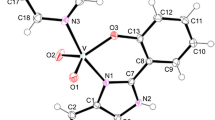Abstract
Background: The insulin-like action of metal complexes on target tissues, including the heart, has been reported in experimental diabetes mellitus. Since streptozotocin-induced diabetes is associated with insulin deficiency and left ventricular dysfunction, this study was designed to determine whether the novel metal complex molybdenum ascorbate [MoO2(aa)2] would improve cardiac function in this model of diabetes.
Methods: Diabetes was induced in Sprague-Dawley rats (n = 6) following an intravenous injection of streptozotocin (60 mg/kg). After 8 weeks of diabetes, cardiac function was determined in isolated working hearts perfused with 11 mmol/L glucose, 1.2 mmol/L palmitate and 3% albumin. MoO2(aa)2 was added directly into the perfusate of working hearts at a concentration of 200 μmol/L for a period of 30 minutes. Age-matched control rats served as controls (n = 6).
Results: Cardiac function, expressed as heart rate (HR) and aortic flow, was significantly decreased in diabetic hearts compared with control hearts. The diabetic state was associated with 23% and 60% reductions in HR and aortic flow, respectively. Short-term addition of MoO2(aa)2 was beneficial and partially prevented the attenuation in diabetic rat heart function. MoO2(aa)2 increased HR by 15%, while aortic flow was increased by 85%. In control hearts, MoO2(aa)2 had no effect on HR and increased aortic flow by 12%.
Conclusion: This study extends previous observations on the benefit of metal complexes in experimental diabetes. Our results indicate that short-term treatment with MoO2(aa)2 partially reversed the left ventricular dysfunction associated with the streptozotocin model of diabetes.



Similar content being viewed by others
References
Thompson KH, McNeill JH, Orvig C. Vanadium compounds as insulin mimics. Chem Rev 1999; 99: 2561–71
Sun Y, James BR, Rettig SJ, et al. Oxidation kinetics of the potent insulin mimetic agent bis(maltolato)oxovanadium(IV) (BMOV) in water and methanol. Inorg Chem 1996; 35: 1667–73
Caravan P, Gelmini L, Glover N, et al. Reaction chemistry of BMOV, bis(maltolato)oxovanadium(IV) — a potential insulin mimetic agent. J Am Chem Soc 1995; 117: 12759–70
Yuen VG, Orvig C, McNeill JH. Comparison of the glucose-lowering properties of vanadyl sulfate and bis(maltolato)oxovanadium(IV) following acute and chronic administration. Can J Physiol Pharmacol 1995; 73: 55–64
Yuen VG, Orvig C, Thompson KH, et al. Improvement in cardiac dysfunction in streptozotocin-induced diabetic rats following chronic oral administration of bis(maltolato)oxovanadium(IV). Can J Physiol Pharmacol 1993; 71: 270–6
Noda C, Masuda T, Sato K, et al. Vanadate improves cardiac function and myocardial energy metabolism in diabetic rat hearts. Jpn Heart J 2003; 44: 745–57
Kannel WB, McGee DL. Diabetes and cardiovascular disease. The Framingham Study. JAMA 1979; 241: 2035–8
Lord SJ, Epstein NA, Paddock RL, et al. Synthesis, characterization, and biological relevance of pyrone and hydroxypyridinone complexes of molybdenum. Can J Chem 1999; 77: 1249–61
Broderick TL, Haloftis G, Paulson DJ. L-propionylcarnitine enhancement of substrate oxidation and mitochondrial respiration in the diabetic rat heart. J Mol Cell Cardiol 1996; 28: 331–40
Broderick TL, Driedzic W, Paulson DJ. Propionyl-L-carnitine effects on postischemic recovery of heart function and substrate oxidation in the diabetic rat heart. Mol Cell Biochem 2000; 206: 151–7
Özcelikay AT, Becker DJ, Ongemba LN, et al. Improvement of glucose and lipid metabolism in diabetic rats treated with molybdate. Am J Physiol Endocrinol Metab 1996; 270: E344–52
Hille R. The mononuclear molybdenum enzymes. Chem Rev 1996; 96: 2757–816
Stiefel EI. Molybdenum(VI). Comprehensive Coordination Chemistry 1986, 36: 1375–1419
Thompson KH, Scott KC, Turnlund JR. Molybdenum metabolism in men with increasing molybdenum intakes: changes in kinetic parameters. J Appl Physiol 1996; 81: 1404–9
Davies MB. Reactions of L-ascorbic acid with transition metal complexes. Polyhedron 1992; 11: 285–321
Raic-Malic S, Svedruric D, Gazivoda T, et al. Synthesis and antitumor activities of novel pyrimidine derivatives of 2,3-O,O-dibenzyl-6-deoxy-L-ascorbic acid and 4,5-didehydro-5-6-dideoxy-L-ascorbic acid. J Med Chem 2000; 43: 4806–11
Dai S, McNeill JH. Ascorbic acid supplementation prevents hyperlipidemia and improves myocardial performance in streptozotocin-diabetic rats. Diabetes Res Clin Pract 1995; 27: 11–8
Tomlinson KC, Gardiner SM, Hebden RA, et al. Functional consequences of streptozotocin-induced diabetes, with particular reference to the cardiovascular system. Pharmacol Rev 1992; 44: 103–50
Dhalla NS, Pierce GN, Innes IR, et al. Pathogenesis of cardiac dysfunction in diabetes mellitus. Can J Cardiol 1985; 1: 263–81
Fernandez-Alvarez J, Barbera A, Nadal B, et al. Stable and functional regeneration of pancreatic beta-cell population in nSTZ-rats treated with tungsten. Diabetologia 2004; 47: 470–7
Barbera A, Gomis RR, Prats N, et al. Tungsten is an effective antidiabetic agent in streptozotocin-induced diabetic rats: a long-term study. Diabetologia 2001; 44: 507–13
Battell ML, Delgatty HL, McNeill JH. Sodium selenate corrects glucose tolerance and heart function in STZ diabetes. Mol Cell Biochem 1998; 179: 27–34
Panneerselvam SR, Govindasamy S. Effect of sodium molybdate on status of lipids, lipid peroxidation and antioxidant systems in alloxan-induced diabetic rats. Clin Chim Acta 2004; 345: 93–8
Li SH, McNeill JH. In vivo effects of vanadium on GLUT4 translocation in cardiac tissue of STZ-diabetic rats. Mol Cell Biochem 2001; 217: 121–9
Mohammad A, Sharma V, McNeill JH. Vanadium increases GLUT4 in diabetic rat skeletal muscle. Mol Cell Biochem 2002; 233: 139–43
Lopaschuk GD. Optimizing cardiac energy metabolism: how can fatty acid and carbohydrate metabolism be manipulated? Coron Artery Dis 2001; 12: S8–S11
Thompson KH, Ckiles J, Yuen VG, et al. Comparison of antihyperglycemic effect amongst vanadium, molybdenum and other metal maltol complexes. J Inorg Biochem 2004; 98: 683–90
Acknowledgements
Thanks are extended to the Heart and Stroke Foundation of New Brunswick (TLB & SAW), Mount Allison University (SAW), the Natural Science and Engineering Research Council (Canada), the Canada Research Chairs Program, and the Canadian Foundation for Innovation/Atlantic Innovation Fund. We also thank Dan Durant (MAU) and Roger Smith (MAU) for expert technical assistance. The authors have no financial interests or other conflicts of interest relevant to the content of this study.
Author information
Authors and Affiliations
Corresponding author
Rights and permissions
About this article
Cite this article
Broderick, T.L., Bailey, J., Gagnon, K.J. et al. Effect of a Novel Molybdenum Ascorbate Complex on Ex Vivo Myocardial Performance in Chemical Diabetes Mellitus. Drugs R D 7, 119–125 (2006). https://doi.org/10.2165/00126839-200607020-00006
Published:
Issue Date:
DOI: https://doi.org/10.2165/00126839-200607020-00006




